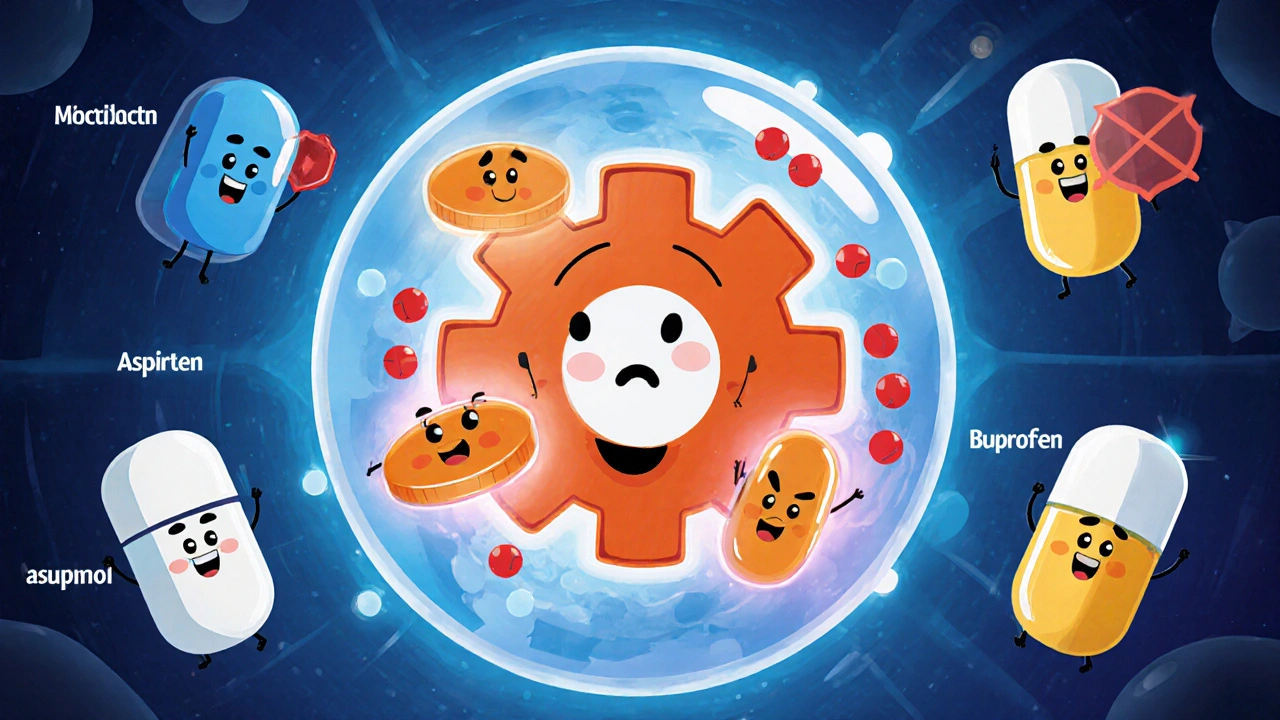
Nurofen is an over‑the‑counter brand of ibuprofen used for pain relief and fever reduction. If you’ve ever stood in the pharmacy aisle wondering whether to grab that pink bottle or try something else, you’re not alone. This guide breaks down how Nurofen stacks up against the most popular alternatives, so you can pick the right one for your headache, muscle ache, or menstrual cramps without guessing.
Ibuprofen belongs to the non‑steroidal anti‑inflammatory drug family, or NSAIDs. It blocks the enzyme cyclooxygenase (COX), which reduces the production of prostaglandins-chemicals that cause pain, inflammation, and fever. By dampening that pathway, Nurofen delivers quick relief, usually within 30 minutes, and its effects can last up to 6 hours.
When you compare Nurofen, you’ll run into a handful of other OTC options. Here’s a snapshot of the big players:
| Attribute | Nurofen (Ibuprofen 200 mg) | Advil (Ibuprofen 200 mg) | Aleve (Naproxen 220 mg) | Aspirin (Acetylsalicylic Acid 325 mg) | Paracetamol (Acetaminophen 500 mg) |
|---|---|---|---|---|---|
| Active ingredient | Ibuprofen | Ibuprofen | Naproxen | Acetylsalicylic acid | Acetaminophen |
| Typical adult dose | 1‑2 tablets every 4‑6 h (max 1.2 g/day) | 1‑2 tablets every 4‑6 h (max 1.2 g/day) | 1 tablet every 8‑12 h (max 660 mg/day) | 1‑2 tablets every 4‑6 h (max 4 g/day) | 1‑2 tablets every 4‑6 h (max 3 g/day) |
| Onset of relief | 30‑45 min | 30‑45 min | 45‑60 min | 45‑60 min | 30‑60 min |
| Duration of action | 4‑6 h | 4‑6 h | 8‑12 h | 4‑6 h | 4‑6 h |
| Common uses | Headache, menstrual cramps, dental pain, fever | Same as Nurofen | Back pain, arthritis, menstrual cramps | Minor aches, heart‑attack prevention (low dose) | Fever, mild to moderate pain, safe for children (when dosed correctly) |
| Key side effects | Stomach irritation, kidney strain, increased bleed risk | Same as Nurofen | Stomach upset, heart‑risk for long‑term use | Stomach bleeding, tinnitus at high doses | Liver toxicity if overdosed |

If you need fast‑acting relief for a sudden headache or a fever spike, the quick onset of ibuprofen makes Nurofen a solid choice. It also packs a stronger anti‑inflammatory punch than paracetamol, which helps with swelling from sprains or menstrual cramps. However, if you have a sensitive stomach or are on blood‑thinners, you might lean toward Paracetamol or a low‑dose Aspirin under doctor guidance.
For chronic joint pain that lasts all day, Aleve’s longer duration can cut down the number of pills you need, which some people find more convenient. But keep in mind the higher cardiovascular risk that comes with naproxen when used long term.
When you compare Nurofen with its peers, the decision hinges on three factors: speed of relief, duration you need, and your personal health profile. Nurofen alternatives like Advil share the same active ingredient, so they’re interchangeable for most people. Aleve trades a slower start for longer coverage, while Paracetamol offers a gentler stomach profile at the cost of less anti‑inflammatory power. Use the table, the checklist, and the quick guide to match the right product to your situation.
Nurofen is formulated for adults, but a liquid ibuprofen product (often labeled as Nurofen Junior) is approved for children from 6 months old. Always follow the weight‑based dosing instructions on the label or ask a pharmacist.
Combining ibuprofen with anticoagulants such as warfarin or direct oral anticoagulants raises bleeding risk. Consult your doctor before mixing them.
Both are NSAIDs, but naproxen stays in the body longer, giving 8‑12 hour pain control, whereas ibuprofen peaks faster and needs more frequent dosing.
NSAIDs can raise blood pressure and reduce the effectiveness of some antihypertensives. Short‑term use is usually okay, but talk to your doctor for chronic pain management.
Mixing ibuprofen and alcohol can increase stomach irritation and liver strain. It’s safest to limit alcohol while using any NSAID.
4 Responses
Ah, the nuanced ballet of over‑the‑counter analgesics is something that merely the discerning palate truly appreciates. When one examines ibuprofen's pharmacodynamics, the rapid cyclooxygenase inhibition offers a swift reprieve that few alternatives can rival, especially for inflammatory etiologies such as dysmenorrhea. Moreover, the elegance of its dosage flexibility-allowing 200 mg increments-provides a granular control that aligns with the modern desire for personalized medicine. While some may be swayed by brand loyalty, the empirical data suggests that Nurofen's formulation delivers a marginally superior absorption profile compared to its generic counterparts, a fact that astute consumers inevitably notice.
i cant help but feel that every pill is like a tiny existential question 🧐... is the pain merely a perception or a truth? nurofen, with its quick onset, reminds us that relief can be instantaneous, yet fragile 😅. the balance of inflammation and comfort is a dance of chemicals, lol. thos who miss the subtlety may just swallow and forget the poetry of prostaglandins. 🌿
The very act of choosing a medine is a reflection of one's inner philosophic quest. If we think of pain as a teacher, then ibuprofen is the sharp but brief lecture, while naproxen drags out the lesson over the day. thsi duality mirrors the ancient debates of immediacy versus endurance, a proper contemplation before any purchase. In that sense, the table you provided is not just data-it is a map of our existential choices.
Listen up, y'all! Nurofen is the real american hero, fast and fierce, just like our great nation! If you got a headache, you grab the pink bottle and boom-relief! Don't let that fancy naproxen fool you with its "long‑lasting" hype. Simple is best, and Nurofen gets the job done without the fancy frills. Trust the power of a straight‑forward NSAID, because drama belongs on the battlefield, not in your medicine cabinet!